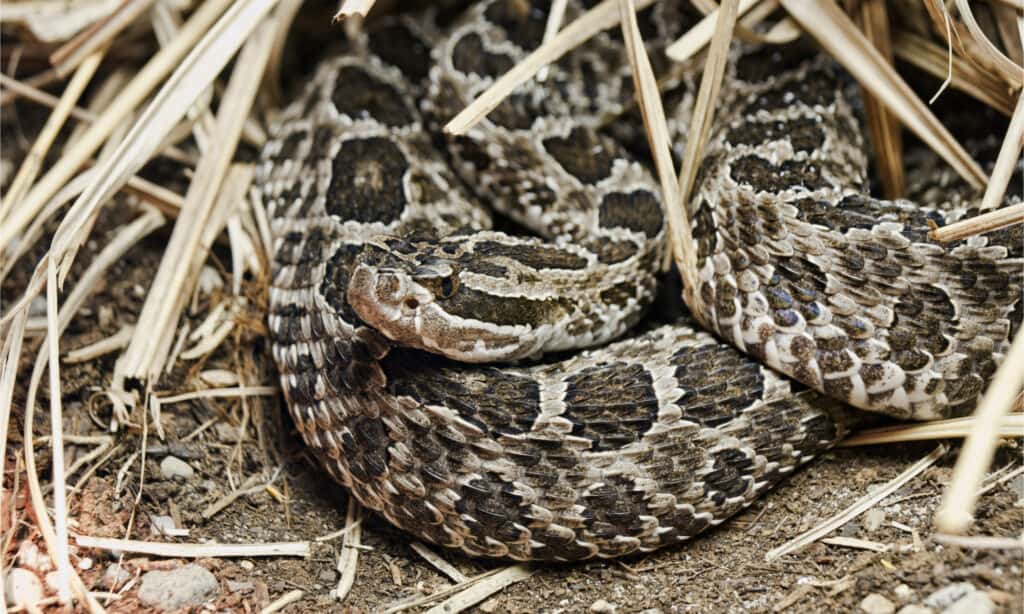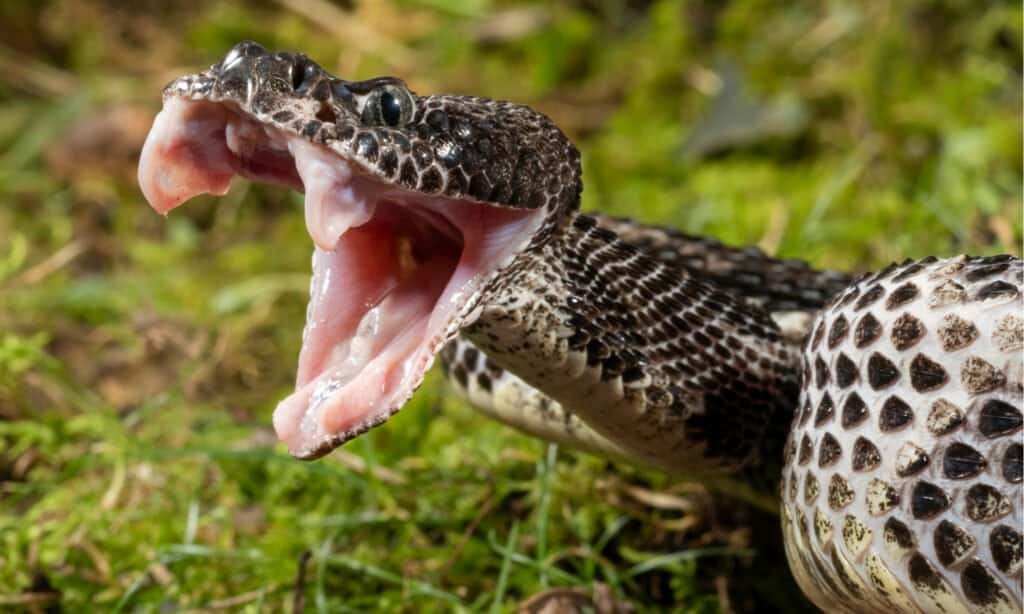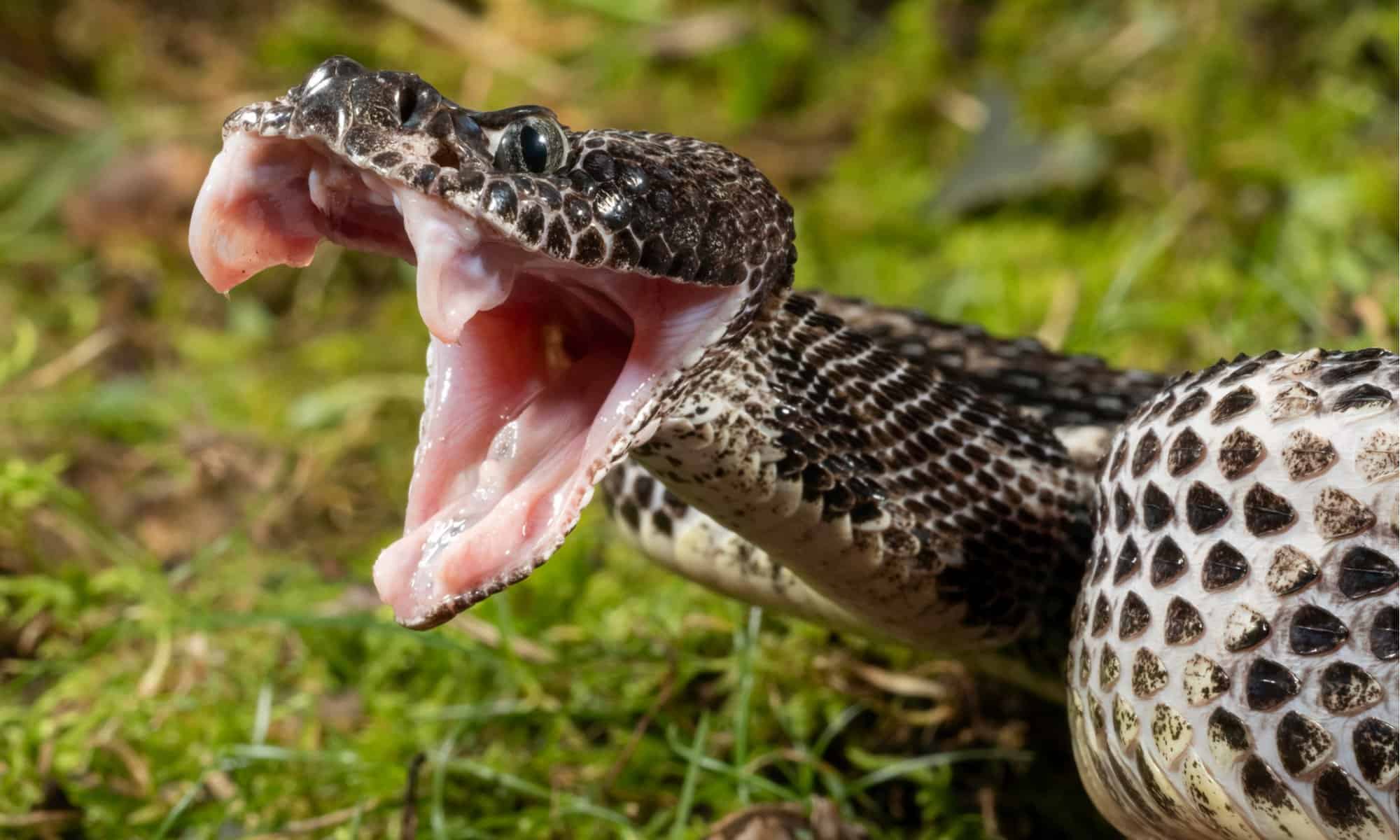It’s getting warm out there. And that means that it’s rattlesnake season in Pennsylvania. They’ve been hiding away for the past six months, surviving their winter hibernation period. But the sun’s hitting those south-facing slopes where they build their dens and it’s time for basking and hunting and getting things done.
Of course, as a human being, unless you’re into hunting these snakes, you’re not likely to want to meet them. But if you do, having the right knowledge in hand could help you along the way.
Let’s look at everything you need to know about rattlesnake season in Pennsylvania.
#1 – Rattlesnakes Come Out in Springtime

Timber rattlesnakes up close are easy to see the stripes and patterns on.
©Matt Jeppson/Shutterstock.com
As air temperatures rise and sunlight hits the south-facing slopes in Pennsylvania, stirrings begin in rattlesnake dens. These reptiles know it’s now time to emerge. This usually happens during late April or early May, depending on how the winter has gone.
Most of your rattlesnake sightings in PA will start about now, as the reptiles emerge and start scoping out food to restore them after a long winter’s nap.
#2 – Rattlesnake Season Ends in October
You’ll continue seeing rattlesnakes throughout natural settings – and sometimes some urban and suburban settings – from April until October when the snakes curl up in their dens once again to wait out the next season.
#3 – Rattlesnakes are Most Active in Summer
Between July and August, rattlesnakes are the most active. This is largely due to mating season kicking in around then.
#4 – Mating Season Starts in Summer Mid-Summer

This Massasauga rattlesnake is coiled and ready to strike.
©Matt Jeppson/Shutterstock.com
Running from mid-July to early September, rattlesnakes are looking for mates and reproducing. Depending on the species females may give birth to anywhere from five to 19 baby snakes per season. And yes – that is correct. Rattlesnakes don’t lay eggs, they give birth.
They’re known as ovoviviparous creatures, which means they carry their eggs for three months, then give birth to live young.
#5 – Rattlesnakes Keep the Same Dens Their Whole Lives
While many animals move around, building new dens or finding new holes to take up residence in, rattlesnakes are sort of homebodies. They will create or find a den early in their lives and maintain the same one their entire lives. Sometimes, this means the same den will be occupied for 30 years or even longer.
#6 – You’ll Spot the Most Rattlesnakes Near Forested, Mountainous Regions of Pennsylvania
While you may occasionally run across a rattlesnake elsewhere in the state, more often than not, you’ll find them near the mountains. They thrive in forested areas where chipmunks, mice and other small mammals range freely and abundantly.
Rattlesnakes in Pennsylvania prefer upland forests, rocky ledges, and boulder fields. They also love outcrops and areas with southern-facing slopes, which ideal for basking in the sunlight to keep themselves warm (since they are naturally cold-blooded).
Rattlesnakes cannot dig their own holes, so they often make dens out of vacant rodent burrows. They’ll resort to wintering under logs and piles of rocks and wood, though, if they can’t find a large enough pre-made den. And though it’s rare, they may find protection under human-made structures, such a decks and porches or houses.
Timber rattlesnakes frequently are spotted basking on roads, along hiking trails in sunny spots, and on rocks along the way.
#7 – Rattlesnakes Live Near Bodies of Water
Just like humans, mammals, and other reptiles, rattlesnakes need water to live. This means they often make their homes near bodies of water. Or they may be seen basking on the shores nearby.
#8 – Rattlesnakes Can Swim

Rattlesnakes do indeed swim.
©Tim Malek/Shutterstock.com
Rattlesnakes are terrestrial snakes, meaning they live on land, but they are excellent swimmers. They may be found in rivers, lakes, ponds, streams, and other bodies of water.
#9 – Pennsylvania Has Two Kinds of Rattlesnakes
Three species of venomous snakes live in Pennsylvania, two of which are rattlers.
Timber Rattlesnakes

Timber rattlesnakes can be camouflaged.
©Frode Jacobsen/Shutterstock.com
Basically, only two regions in Pennsylvania are Timber Rattler free: along the western border and in parts of the southeast. These areas don’t have enough of the kind of habitat they need, as they’re less forested. Timber rattlesnakes are some of the biggest rattlers in the United States, growing to between 36 and 60 inches long.
What Do Timber Rattlers Look Like?
Technically, they’re pit vipers, and they have large, broad, triangular-shaped heads. The heads may be yellow, tan, or gray, while their bodies are heavy and thick and might be gray, tan, yellow, or brown. They typically have a brown stripe running down the middle of their backs along the spine, with black tails. Dark chevrons or V-shaped markings help to distinguish the snakes from others.
And, of course, the timber rattlesnake bears the signature buttons that make up the “rattle” that gives them their name. Heat-sensing pits between their eyes and nostrils help them detect prey and predators nearby and earn them the classification of “pit viper.”
What Do Timber Rattlers Eat?
Small mammals like cotton rats, chipmunks, deer mice, and voles are the favorite tasty treats of Timber rattlesnakes. They’ll eat birds like bobwhites or frogs, as well. They’ll also hunt down and eat garter snakes.
Are Timber Rattlesnakes Aggressive?
Though they have fatal venom for victims untreated by antivenom, Timber rattlesnakes are not particularly aggressive snakes. They’d much rather hide and use their natural camouflage to keep away from humans and predators. If they’re frightened, they may well shake those rattling tails in the hopes of warning off predators.
Only if the snake feels threatened (i.e., you don’t get out of there!) will it attack. They’d much rather blend into the background and forget you ever existed than waste their time on you. Timber rattlesnake attacks are rare, thankfully.
Anything Special to Note on Timber Rattlesnakes?
Rocky ledges are a favorite spot for pregnant female Timber rattlesnakes. They’re here because giving birth is a lot easier in areas like this, particularly in the summertime. Often, before birthing, they’ll even just lay out basking for a while, enjoying the warmth and preparing their bodies for the labor to come.
Eastern Massasauga Rattlesnakes

Massaugas are rare in Pennsylvania, but sometimes hikers may come across them.
©DnDavis/Shutterstock.com
The other type of rattlesnake you could spot in Pennsylvania is the Eastern Massasauga rattler. This one is far rarer, though, and generally only spotted in the northwestern corner of Pennsylvania. Eastern Massasauga rattlesnakes are a federally protected snake, though, so if you do spot one, you’ll absolutely need to leave it alone.
What Do Massasauga Rattlesnakes Look Like?
Typically growing to between 20 and 30 inches in length, Massasauga rattlers are much smaller than Timber rattlers in most cases. Their light gray bodies are covered in black or dark brown patterns with small blotches along their backs and sides. They have thick, heavy bodies with dark and light stripes along both sides of their heads.
Juvenile massasaugas look just like adults, only much smaller, typically around 9 inches long. They have yellow-tipped tails. Juveniles often also lack the rattle as they’re only born with one button. As they mature and shed their skins a few times each year, they will grow more buttons.
What Do Massasauga Rattlesnakes Eat?
Mealtime for massasaugas looks pretty similar to that of the Timber rattlesnake. They eat small mammals, reptiles, invertebrates, and yes, other snakes as well. Juveniles tend to go after reptiles and other snakes more often than mammals.
Are Massasaugas Aggressive?
Like Timber rattlers, massasaugas are pit vipers that carry some fatal venom in their bite. They’re not aggressive, though, and are only known to attack when they feel threatened. They’re actually pretty tame and considered mild-mannered by many. They definitely don’t go out of their way to find humans and would prefer to stay hidden. They have tiny rattles and may not even be heard by humans or their rattles are mistaken for insect noise.
Generally, they don’t even attack humans unless they’re being handled. That being said, it’s never a good idea to touch a snake in the wild – mild-mannered or not.
Where Do Eastern Massasauga Rattlers Live?
Massasaugas prefer wetland habits for the majority of the year. Depending on the season, though, they may move around a bit to find the best hunting and breeding grounds. Most often in spring, fall, and winter, they’ll be living it up in poorly drained and low-lying places. Summertime, though, draws them to warmer, dry habitats like fields, prairies, and meadows.
Anything Special to Note About Massasauga Rattlesnakes?
Massasauga rattlesnakes are also live-bearing snakes. Pregnant females will be seen basking in the sun in dry areas before giving birth (usually in August and September. They’ll frequently settle into vegetative areas and stay a while, making themselves as comfortable as possible before the ordeal.
#10 – Wildlife Agencies Impact the Rattlesnakes of Pennsylvania By Enforcing Strict Regulations

Timber Rattlesnakes have a black, green, and brown scaling pattern
©Scott Delony/Shutterstock.com
Laws in Pennsylvania prevent folks from harming rattlesnakes or damaging their nesting grounds. And in the case of the Massasauga rattlesnake, they are actually federally protected and listed on the Endangered Species Act. Hefty fines accompany the harming of these snakes.
Timber rattlers aren’t on the Endangered Species list, but special permits exist for dealing with them (see below).
#11 – Rattlesnake Venom May Be Fatal But Not Always
Neither the Timber rattlesnake nor the massasauga rattler have any desire to mess with humans. Slithering off into the bush and getting away from you as quickly as possible is the desired outcome of any interaction. However, if the reptiles feel threatened, they may attack.
The venom of either rattlesnake is potent enough to be deadly. However, unless the bite goes untreated, they are rarely fatal. This is because antivenom drugs are prescribed and are exceptionally effective. The first fatal bite report in 25 years was in 2022.
#12 – The Odds of Being Bitten By a Rattlesnake in Pennsylvania
The odds of being bitten by a rattlesnake in Pennsylvania is thankfully, quite low. Annually, Pennsylvania Fish and Commission are made aware of no more than 2 to 3 bites annually from non-captive venomous snakes. Most of the time, there aren’t even that many.
#13 – Symptoms of a Rattlesnake Bite

Their venom is cytotoxic, which means it destroys cells. It can cause severe pain, swelling, bleeding, tissue damage, and even death if left untreated.
©joloei/Shutterstock.com
Tissue damage, painful swelling, and bruising are the most frequent symptoms of a rattlesnake bite, assuming it is dealt with shortly with medical treatment. It takes several hours for a bite to become lethal, but the longer it takes to get to medical care, the more intense these symptoms become.
In some cases, the bites will leave discoloration and texture changes as a result of tissue damage. For some, these never go away.
#14 – There Are 21 Snake Species in Pennsylvania, and Only Three Are Venomous
With about half as many snakes species in Pennsylvania as other states, like Arizona, very few of them are venomous. In fact, only three venomous snake species live in the state. The two rattlesnakes (Eastern massasauga and Timbe rattler) and copperheads. The other 18 species are predominantly harmless and often considered beneficial species.
#15 – Damaging a Rattlesnake Den is Prohibited
State laws in Pennsylvania prohibit any person from damaging known snake dens and habitats, even those of rattlesnakes.
#16 – You Need a Special Permit to Hunt Rattlesnake in Pennsylvania
If you’re itching to hunt down some rattlesnakes in Pennsylvania, be aware that you’ll need a specialized permit for the purpose. See the state’s regulations to determine if you would qualify for the permit and learn the regulations surrounding its use.
#17 – Baby Rattlesnakes Are Not More Venomous Than Adults
The myth is that baby rattlesnakes are more venomous somehow than adults. It isn’t true, though. Baby snakes are actually less dangerous than the grown-up versions for the opposite reason that the myth claims their higher danger. Baby snakes have less venom, not more concentration of it, than adults.
#18 – Rattlesnake Safety

Timber rattlesnakes are non-aggressive, but that doesn’t mean they’re safe.
©Joe McDonald/Shutterstock.com
Though rattlesnakes in Pennsylvania are non-aggressive, there are still precautions needed when you’re out in the wilderness or near habitats.
Never Permit Dogs to Wander Leash-Free
Because of the curious nature of dogs, they often find themselves in trouble when it comes to rattlesnakes. They are far more likely to be victims of bites than humans. Keep them on leashes to prevent them from investigating snakes.
Most Bites Occur Because of Handling
While it might seem like an unnecessary reminder: Do not pick up or handle rattlesnakes in the wild. Getting too close, touching them, picking them, or otherwise disturbing rattlesnakes are the primary reasons people are bitten by venomous snakes.
Watch Where You’re Putting Your Feet
When you’re out hiking or even just meadow walking, it’s important to keep an eye on your next step. Both types of rattlesnakes in Pennsylvania are masters are blending in. So, they are often stepped on by accident by folks not looking where they are going. Always look ahead to your next foot place before proceeding.
Stick to Trails
When out in the wilderness, be sure to stick to the trails. Snakes are more visible on trails than they are offside. Additionally, tall grasses and heavy underbrush are primary locations for snakes on the move. Stay on trails to avoid unnecessary and unexpected encounters with rattlers.
Check Your Seat or Handhold
Much like you should look where you step, you should also look where you’ll be sitting down. Avoid putting your hands or feet or backsides on boards, logs, benches, rock piles, and other such locations as a snake could be sunning itself.
Never Pick Up Dead Snakes
If you come across a dead rattlesnake, never pick it up. The snake remains venomous and the natural reflexes can provoke the snake’s body into biting and injecting venom.
Back Away Carefully
If you come across a live rattlesnake, give it a wide berth. If you’re coming up on it along a trail, back away slowly from the snake and avoid making sudden moves. The purpose is to avoid startling the snake, which could make it feel threatened.
Avoid Milky-Eyed Snakes
If you notice a snake has white or cloudy eyes, be particularly careful. This is a sign of shedding, which means the snake cannot see as well as it usually does. Therefore, the snake is more dangerous and more vulnerable than usual. They may strike out of sheer panic.
If Bitten, Stay Calm and Seek Medical Attention Immediately
If you are somehow bitten by a rattlesnake, it’s important to remain calm. Do not attempt to treat the bite yourself, but rather aim to keep your heart rate low and carefully and calmly leave the area. Go to the nearest hospital as quickly as you are able, without running, and seek medical treatment. If safe to do, snap a picture of the snake from a distance to help medical care personnel identify the snake.
Discover the "Monster" Snake 5X Bigger than an Anaconda
Every day A-Z Animals sends out some of the most incredible facts in the world from our free newsletter. Want to discover the 10 most beautiful snakes in the world, a "snake island" where you're never more than 3 feet from danger, or a "monster" snake 5X larger than an anaconda? Then sign up right now and you'll start receiving our daily newsletter absolutely free.
Thank you for reading! Have some feedback for us? Contact the AZ Animals editorial team.








